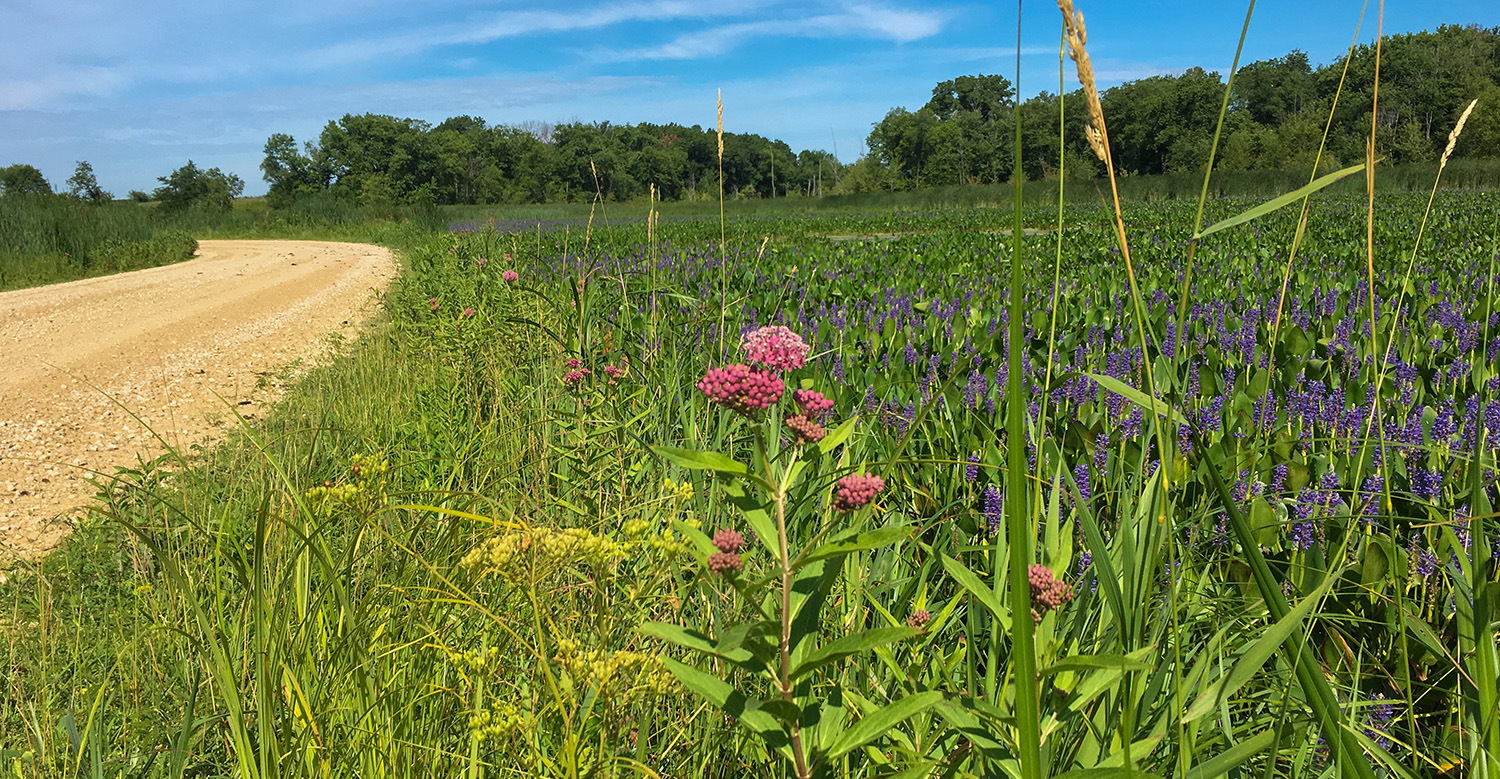Public Outreach
Public Outreach thompsbb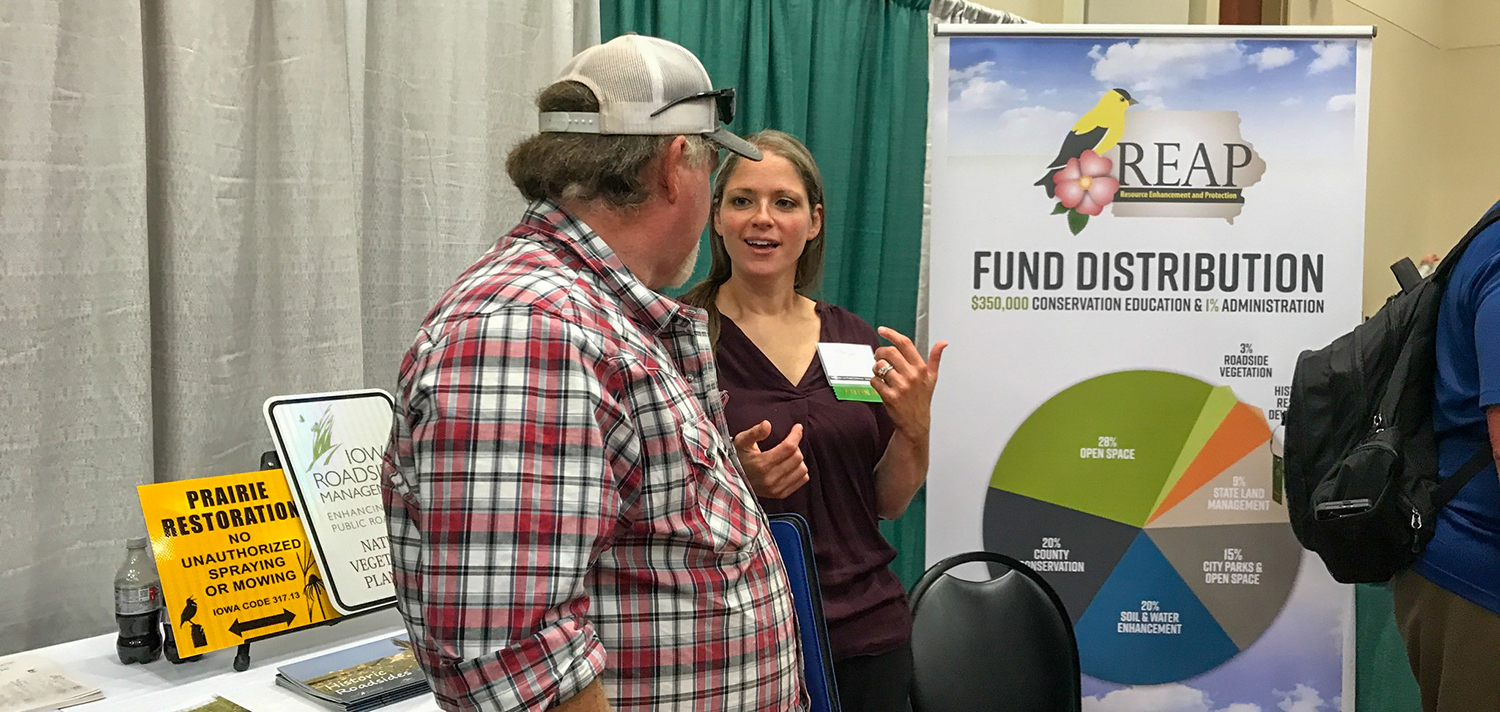
Programs, Partnerships, and Events
Public Meetings and Community Events
Attending community events and public meetings can be an effective way to engage with the community. For example, some roadside managers have a booth at the county fair. Other events that may offer opportunities to set up an information booth include city festivals, Independence Day celebrations, harvest festivals, free outdoor concert series, farmers markets, and more.
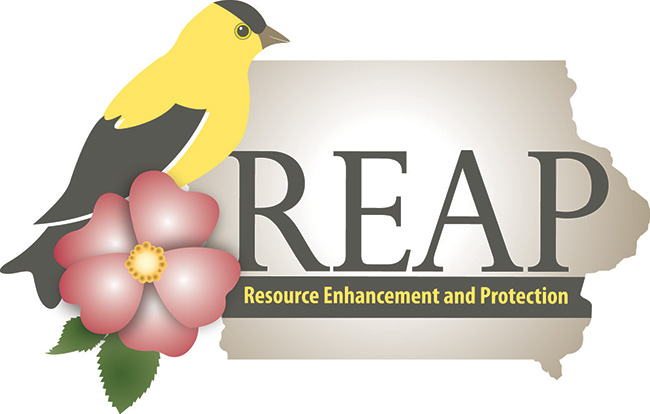 In odd-numbered years, the Iowa Department of Natural Resources holds Resource Enhancement and Protection (REAP) regional assemblies around Iowa. These assemblies are public meetings where citizens can learn about REAP expenditures and provide feedback. Since 3% of REAP funding goes toward roadside vegetation management, roadside managers often attend the meetings in their regions to answer any questions about how those dollars are spent on managing local roadside vegetation.
In odd-numbered years, the Iowa Department of Natural Resources holds Resource Enhancement and Protection (REAP) regional assemblies around Iowa. These assemblies are public meetings where citizens can learn about REAP expenditures and provide feedback. Since 3% of REAP funding goes toward roadside vegetation management, roadside managers often attend the meetings in their regions to answer any questions about how those dollars are spent on managing local roadside vegetation.
County board of supervisor meetings and city council meetings also provide opportunities to convey to the public what you do and why you do it. Citizens who are active in local government attend in person. Others may watch the meetings on local government television channels, and many meetings are streamed live and/or archived online. Local reporters may be in attendance, providing an opportunity for additional media coverage. Maintaining a good relationship with supervisors and councilors as described above is a great way to get invited to meetings. But do not hesitate to reach out to staff who set the agendas for these meetings if you have not presented recently. See Chapter 2: Steps to Start a Roadside Vegetation Program for more on being a part of these meetings in the early stages of implementing an IRVM program.
Organizing Volunteer Events for Residents
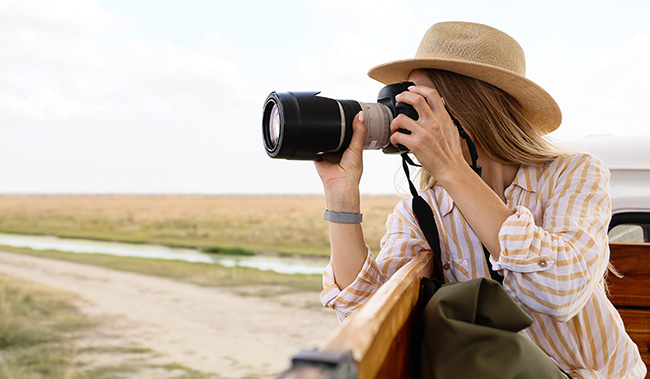
Volunteers familiar with the roadside program may be able to assist with community outreach through activities such as giving educational talks, writing letters to the editor supporting the roadside program, and taking attractive roadside photos. Organized events such as roadside trash cleanups could be a good activity for groups. Although coordinating with volunteers takes time, their involvement can generate support for the program and result in media coverage.
Presentations for Community Groups and Schools
In every community, there are organizations and entities looking to fill time at their meetings with presentations about what is happening in the community. Members of these groups tend to be very involved in the community and have positive relationships across all sectors of public life. They are great to have as allies. Groups that roadside managers have spoken to include local chapters of master gardeners, master conservationists, Sierra Club, Pheasants Forever, Rotary Club, and Kiwanis Club. The TPC roadside program manager has a PowerPoint template with information about the benefits of roadside programs that roadside managers can request and modify to suit their needs.
Roadside managers have also spoken to school classes and extracurricular groups. The TPC roadside program manager may have stickers available for roadside managers that are popular with schoolchildren. If your county has a TPC root banner, bring it with you and invite children to lay down next to the banner so they can be amazed by how their height compares. Other educational activities related to prairie roots that meet Iowa educational standards are provided on the Educator Resources page of the TPC website.
Press Releases
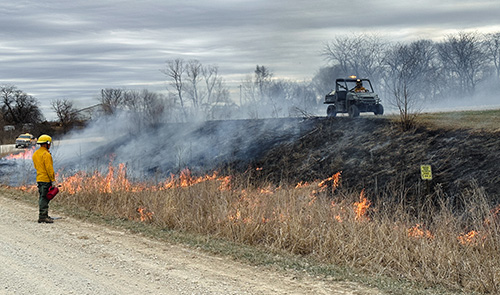
Press releases can be used to notify landowners and the public about upcoming work to maintain transparency. You can also notify local reporters in order to generate media coverage for instances such as hiring a new roadside manager, receiving grant funding, and re-approval of the county or city IRVM plan. Some roadside managers also annually issue a press release about Iowa's mowing law, which restricts citizens from mowing roadside vegetation before July 15, with some exceptions. See Appendix 3A for a sample press release on this topic.
County or city communication staff can help write and distribute press releases. If you are distributing them on your own, email them (in the body of the email) to any reporters who have covered your work in the past and any generic or press release email addresses at local newspapers and television stations.
Collaborating With Nonprofit Organizations
Assisting with events such as field days and prescribed prairie burns hosted by nonprofit organizations can lead to valuable partnerships and publicity.
Providing Equipment Rentals
Some county roadside programs, especially those located within the conservation department, will rent equipment such as seed drills to the public to build goodwill with the community.
Adopt-a-Prairie Program
A few county roadside programs have partnered with landowners to reestablish prairie vegetation in the roadside bordering their property. Landowners can apply and, if approved, the roadside manager removes the existing vegetation and replaces it with native vegetation. There does not need to be a road regrading project associated with the reseeding. See an example application for participating in an adopt-a-prairie program from Scott County.
Outreach Materials and Signage
Signage for Plantings
Installing signage lets the public know that a planting is intentional and can help to avoid the perception that native roadside vegetation is just a bunch of weeds. Use signage in plantings and high-quality areas to showcase native species. Some counties prefer to print their own signs that include the county logo. Iowa Prison Industries is commonly used to print signs for local governments. Signs can include language such as “Roadside Prairie” or “Native Vegetation—Do Not Mow or Spray.” Counties that have an adopt-a-prairie program for residents and want a large number of signs can check with the LRTF coordinator to see if they can apply for an LRTF grant to cover the cost. Counties can also obtain signs from the TPC roadside program manager, who uses LRTF funds to pay Iowa Prison Industries to print a limited number of signs each year. Check with the program manager for sign availability.
For landowners who want to know where they can get signs for their prairie plantings on private property, see suggestions from the TPC.
Frequently Asked Questions
As you communicate with various constituencies, they are likely to have questions, a good sign they are interested and engaged. To help you as you field questions, the TPC website includes a list of frequently asked questions and responses regarding roadside vegetation management. If you are frequently asked questions that you think would be helpful for others to see on the FAQ page, let the TPC roadside program manager know.
Posters and Guidebooks
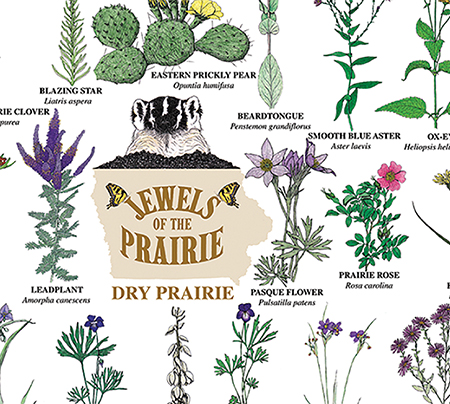
The Living Roadway Trust Fund has free eye-catching posters available such as the seven beautifully illustrated guides to prairie plants and animals in the “Jewels of the Prairie” poster set; the pollinator poster series; and a “Roadsides of Opportunities” poster.
The LRTF also has free spiral-bound guidebooks on how to identify pollinators, seedlings, trees, and shrubs. These books are great to have available when tabling at community events. The TPC roadside program manager may also have some available.
Brochures
Roadside Management Series
The TPC roadside program manager has brochures on roadside vegetation topics such as Iowa’s mowing law and landowner questions regarding roadsides.
How to Restore Prairie
The TPC has a set of 10 brochures that provide detailed how-to technical information for topics such as collecting seed, designing seed mixes, site preparation, seeding, and maintaining plantings. The information is distilled from the TPC Guide to Prairie Restoration in the Upper Midwest.
Banners and Roots
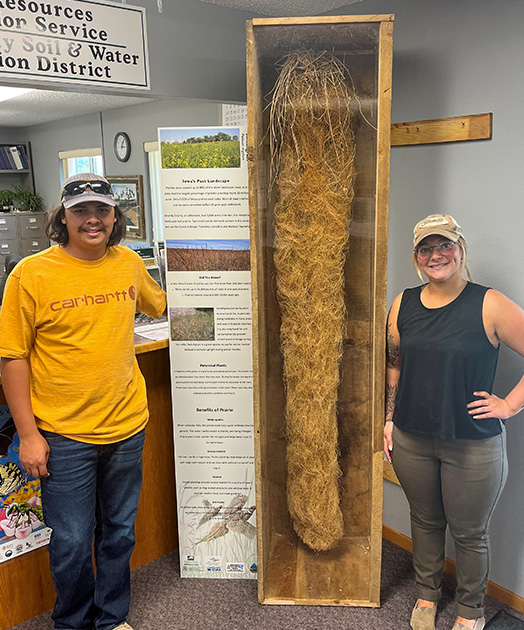
Banners with life-size images of roots available for ordering from the TPC capture people’s attention by conveying the tremendous density and size of prairie root systems like those found in roadside vegetation. Approximately 14-feet long when unfurled, these portable and durable banners roll up for easy storage. Some counties or cities display them in the local nature center, library, or county courthouse.
Prairie Root Specimens
Prairie root specimens ) from the TPC that are up to ten feet long are especially effective physical tools for public outreach. Similar to the prairie root banners, counties may display prairie root specimens at the local nature center, library, or county courthouse. To cover the cost of growing the roots over three years, the TPC charges over $2,000 per root specimen plus shipping.
Other Promotional Materials
Stickers
The TPC roadside program manager may have stickers available for request that read “Roadsides for Wildlife” or have the Iowa Roadside Management logo.
Pull-up Banner
The TPC roadside program manager may have pull-up banners with roadside vegetation information that can be borrowed for tabling at local community events. They may be shipped or picked up at the TPC in Cedar Falls.
Wall Calendar
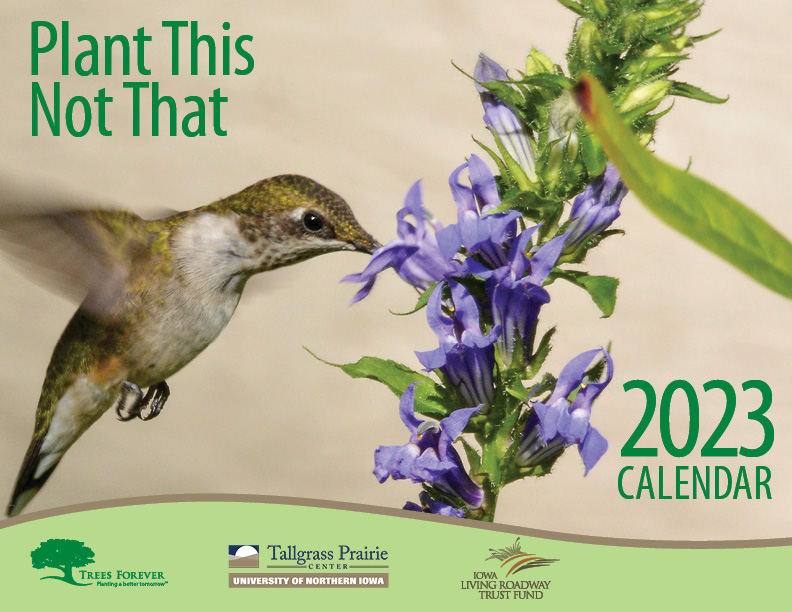
The TPC roadside program manager produces an annual wall calendar with a theme related to roadside vegetation management. Previous themes have included “Historic Roadsides,” “Celebrating Remnants,” and “Plant This Not That.” Wall calendars are mailed to roadside programs in the fall.
Lesson Plans
The following lesson plans are available at the Tallgrass Prairie Center website.
Roadside Curriculum
The Iowa Roadside Management Office collaborated with a team of Iowa educators to create nearly 30 educational activities that relate to roadside vegetation, with topics including changes in roadside vegetation over time, how we define what a weed is, and looking for roadside wetlands.
Prairie Roots Lessons
In collaboration with the Tallgrass Prairie Center, a team of Iowa educators created a set of prairie roots lesson plans that align with Iowa Core standards for upper-elementary and middle-school students. Roadside managers can share the lessons with local educators or teach them when visiting schools.
Social Media
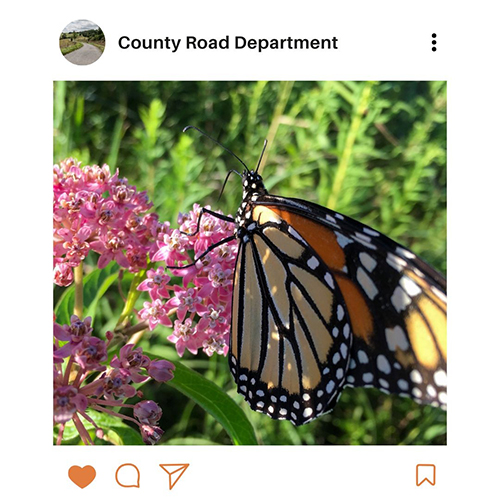
Social media platforms like Facebook, Instagram, and others are great ways to engage with those who support your efforts and other users (through shares from your followers) alike. It is most common for roadside programs to occasionally help draft posts for larger umbrella social media accounts, such as the county conservation board, county road department, or the main county or city accounts. A few roadside programs also have their own social media accounts. It is best to post at least once a week to encourage engagement and garner reach.
The TPC roadside program manager maintains Iowa Roadside Management Facebook, Instagram, and YouTube accounts.
Recordkeeping and Cost Data
Good recordkeeping is an important part of effective communication because it facilitates transparency, builds trust, and helps to justify the roadside manager position. Accurate and up-to-date digital recordkeeping is a vital part of a roadside manager’s job and should be started immediately. Detailed, readily-accessible records provide an easy data supplement (including number of acres planted, volume of seed obtained through the Tallgrass Prairie Center's Iowa Roadside Management Office, and the number of locations sprayed) when roadside managers report to county boards of supervisors or city councils.
Documenting expenses and material use is particularly useful, as it can be used as proof of the money and labor-saving benefits of IRVM, particularly when it comes to reduction of mowing and spraying. It is advisable to keep separate records for herbicide applications, as roadside managers are required to document every time they spray.
As mentioned earlier, records documenting locations of roadside plantings are especially useful. Many roadside managers have partnered with their county’s geographic information system (GIS) division to develop useful tools for this purpose.
Report About Public Perspectives on Roadside Vegetation
In 2016, Trees Forever received funding from Living Roadway Trust Fund to oversee research on how key stakeholders, legislators, and other citizens view LRTF’s mission. Reports summarized results related to target audiences, resonating messages, and ways to drive engagement and support. These findings may be useful as you conceptualize your communications plan.
More on Communication Strategies
For more information on internal and external communications strategies related to roadside vegetation management, see the National Academies of Sciences’ “Pollinator Habitat Conservation Along Roadways, Volume 10: Midwest” guide, "Chapter 11: Communication Support.”
